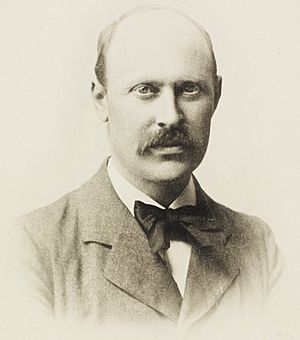Jakob Jakobsen facts for kids
Quick facts for kids
Jákup Jakobsen
|
|
|---|---|
 |
|
| Born | 22 February 1864 |
| Died | 15 August 1918 (aged 54) |
| Occupation | Philologist |
| Title | Doctor |
| Signature | |
Jakob Jakobsen (born February 22, 1864 – died August 15, 1918) was an important scholar and linguist from the Faroe Islands. He was the first person from the Faroe Islands to earn a doctoral degree, which is a very high university qualification. His main work was about the Norn language, which was once spoken in Shetland. His research helped a lot to save information about this old language.
Jakobsen also helped develop the Faroese language and its literature. He had a famous disagreement with Venceslaus Ulricus Hammershaimb about how to write Faroese. Jakobsen wanted a writing system based on how words sound (a phonetic system), but his idea was not chosen.
Contents
Jakob Jakobsen's Early Life and Education
Jakob Jakobsen was born in Tórshavn, the capital of the Faroe Islands. His parents were Hans Nicolai Jacobsen and Johanne Marie Hansdatter. Jakob was the youngest of three children, with two older sisters.
His father, H. N. Jacobsen, worked as a bookbinder and owned a bookshop in Tórshavn. This shop, H. N. Jacobsens Bókahandil, started in 1865. It is still open today and is one of the oldest shops in the Faroe Islands. The shop even has a traditional Faroese grass roof!
Jakobsen's Schooling and University Studies
Jakob Jakobsen went to the "realskolen" school in Tórshavn. There, he showed a natural talent for learning different languages. When he was thirteen, he moved to Denmark for more schooling. He finished college in Herlufsholm in 1883.
In 1891, he graduated from university. His main subject was Danish, and he also studied French and Latin. In 1897, he earned his doctoral degree. His important work was titled "det norrøne sprog på Shetland," which means "the Norse language in Shetland."
Later in his life, one of Jakobsen's sisters helped him a lot in Copenhagen. After he passed away, she translated his works about Shetland into English. This was something Jakobsen himself had planned to do.
Jakobsen's Contributions to the Faroese Language
Jakob Jakobsen did a lot of important work for the Faroese language. He focused on folklore and oral poetry. This work was very important for the rise of modern Faroese written literature.
Collecting Faroese Stories and Legends
His most famous work in this area is his collection of Faroese legends and folktales, called Færøske Folkesagn og Æventyr. He saw folktales as a type of fictional story. However, he believed legends could be a source of information about early Faroese history. He also collected oral poems and studied Faroese place-names.
Jakobsen was the first to find some Celtic place-names in the Faroe Islands. He also helped create many new words, called neologisms, for the Faroese language. He wrote the grammar section and provided text examples for the 1891 Færøsk Anthologi, which was edited by V. U. Hammershaimb.
The Debate Over Faroese Writing (Orthography)
In 1898, Jakob Jakobsen suggested a new way to write Faroese. This new system was based on a science called phonetics. Phonetics studies how sounds are made in speech. His idea was that each sound should have its own unique letter. He also believed this new writing system would be easier for children to learn.
However, there was a lot of political disagreement about his proposal. Because of this controversy, his idea for a new Faroese orthography was not adopted.
Jakobsen's Work in Shetland
Jakob Jakobsen is a very important person in Shetland's culture. His book, "Dictionary of the Norn Language in Shetland, is the best source of information about the old Shetland language. This dictionary explains where words came from and how they were used.
Researching the Norn Language
Jakobsen did his research in Shetland between 1893 and 1895. The dictionary was first published in Danish in four parts from 1908 to 1921. Later, it was published in English in two volumes in 1928 and 1932. This dictionary is now known around the world as a major work of scholarship in Scandinavian language studies.
When Jakobsen first traveled to Shetland, he knew very little about the local language. He had only read a few old glossaries and stories. In Edinburgh, he met Gilbert Goudie, who helped him. During his fieldwork in Shetland, Jakobsen talked to many people who spoke the Shetland dialect. He also met with scholars like Haldane Burgess and Laurence Williamson.
Jakobsen's letters with Gilbert Goudie were put into a book by E. S. Reid Tait in 1953. In 1981, Roy Grønneberg published a study called Jakobsen and Shetland, which looked at Jakobsen's important connection to the islands.

